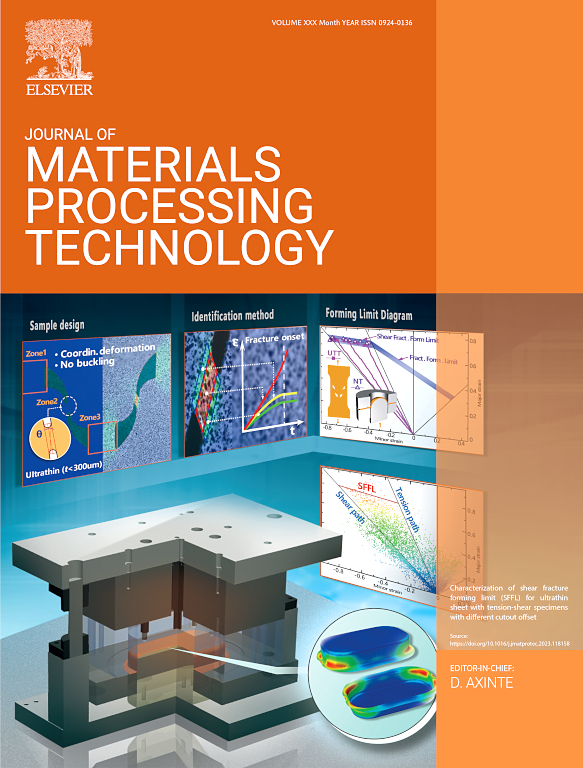Dual-pulse arc modulation for enhanced microstructural homogeneity and mechanical isotropy in high-strength aluminum alloy additive manufacturing
IF 7.5
2区 材料科学
Q1 ENGINEERING, INDUSTRIAL
Journal of Materials Processing Technology
Pub Date : 2025-07-15
DOI:10.1016/j.jmatprotec.2025.118986
引用次数: 0
Abstract
Fabricating high-strength Al-Zn-Mg-Cu alloy components via wire-arc directed energy deposition (DED) remains challenging due to inherent defects and anisotropic mechanical properties caused by uncontrolled heat input. This study introduces a dual-pulse modulated variable polarity arc additive manufacturing process as a fundamental advancement in addressing these limitations. By cyclically modulating the peak/base current ratio, the process induces periodic electromagnetic stirring and thermal oscillations in the molten pool, which fundamentally alters solidification dynamics. This innovation achieves a self-regulating cyclic microstructure of alternating fine equiaxed and columnar grains (aspect ratio reduced to 2.91), eliminates porosity (reduced to 0.65 %), and weakens the dominant <001> texture (pole density reduced from 17.47 to 9.88), thereby enhancing mechanical isotropy. Critically, the method refines grains by 50 % without altering nano-precipitate phases (η', 15–25 nm), preserving intrinsic precipitation strengthening. Post-deposition T6 heat treatment yields a tensile strength of 545.4 MPa, comparable to wrought counterparts, while retaining elongation (8.4 %). The work establishes a scalable, non-alloying strategy to suppress defects and anisotropy in high-strength aluminum alloys, advancing wire-arc DED toward aerospace-grade applications through precise arc energy modulation and molten pool control.
高强度铝合金增材制造中增强组织均匀性和力学各向同性的双脉冲电弧调制
由于不受控制的热输入导致的固有缺陷和各向异性力学性能,通过线弧定向能沉积(DED)制造高强度Al-Zn-Mg-Cu合金部件仍然具有挑战性。本研究介绍了一种双脉冲调制变极性电弧增材制造工艺,作为解决这些限制的基本进步。通过循环调节峰基电流比,该工艺在熔池中引起周期性的电磁搅拌和热振荡,从根本上改变了凝固动力学。这一创新实现了细小等轴晶和柱状晶交替的自调节循环微观结构(长径比降低到2.91),消除了孔隙率(降低到0.65 %),并削弱了主导的<;001>;纹理(极密度从17.47降低到9.88),从而增强了机械各向同性。重要的是,该方法在不改变纳米析出相(η′,15-25 nm)的情况下,使晶粒细化了50 %,保持了本质的析出强化。沉积后T6热处理的抗拉强度为545.4 MPa,与变形后的强度相当,同时保持伸长率(8.4 %)。这项工作建立了一种可扩展的非合金化策略,以抑制高强度铝合金中的缺陷和各向异性,通过精确的电弧能量调制和熔池控制,将线弧DED推进到航空级应用。
本文章由计算机程序翻译,如有差异,请以英文原文为准。
求助全文
约1分钟内获得全文
求助全文
来源期刊

Journal of Materials Processing Technology
工程技术-材料科学:综合
CiteScore
12.60
自引率
4.80%
发文量
403
审稿时长
29 days
期刊介绍:
The Journal of Materials Processing Technology covers the processing techniques used in manufacturing components from metals and other materials. The journal aims to publish full research papers of original, significant and rigorous work and so to contribute to increased production efficiency and improved component performance.
Areas of interest to the journal include:
• Casting, forming and machining
• Additive processing and joining technologies
• The evolution of material properties under the specific conditions met in manufacturing processes
• Surface engineering when it relates specifically to a manufacturing process
• Design and behavior of equipment and tools.
 求助内容:
求助内容: 应助结果提醒方式:
应助结果提醒方式:


